De Montfort University: Business Strategy Analysis and Recommendations
VerifiedAdded on 2020/03/02
|8
|1199
|225
Report
AI Summary
This report provides a comprehensive analysis of De Montfort University's business strategy. It begins with a SWOT analysis, evaluating the university's strengths, weaknesses, opportunities, and threats. The report then applies Porter's competitive forces model to assess the competitive landscape and identifies the necessary competencies and resources for distance learning courses. The analysis further explores the existing competition faced by De Montfort University, especially from European and US universities, and suggests organizational changes required for effective distance learning programs. Finally, the report offers recommendations, emphasizing the integration of teaching methods, the importance of structured online schedules, and the need for clear communication to attract and retain students. The report concludes with a list of relevant references.
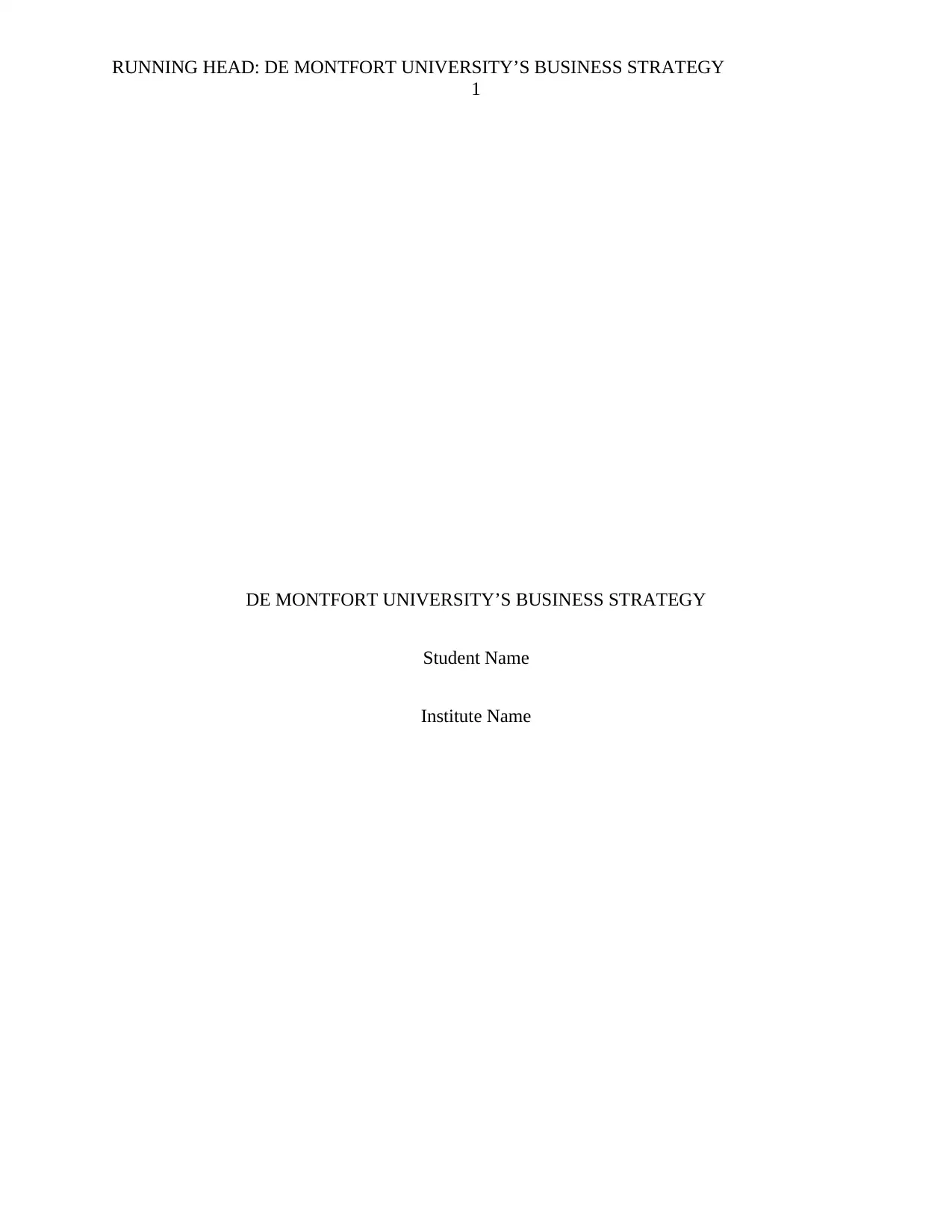
RUNNING HEAD: DE MONTFORT UNIVERSITY’S BUSINESS STRATEGY
1
DE MONTFORT UNIVERSITY’S BUSINESS STRATEGY
Student Name
Institute Name
1
DE MONTFORT UNIVERSITY’S BUSINESS STRATEGY
Student Name
Institute Name
Paraphrase This Document
Need a fresh take? Get an instant paraphrase of this document with our AI Paraphraser
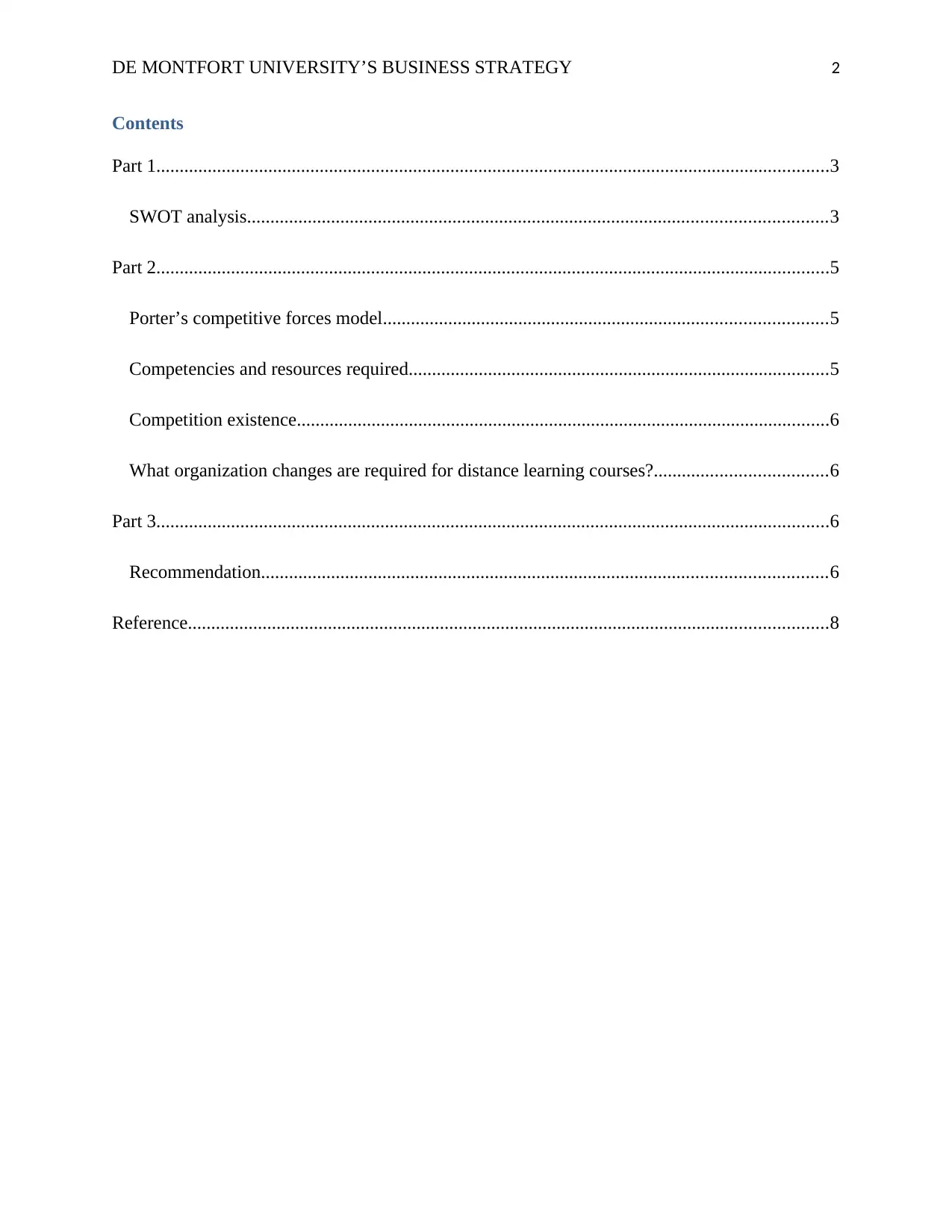
DE MONTFORT UNIVERSITY’S BUSINESS STRATEGY 2
Contents
Part 1................................................................................................................................................3
SWOT analysis............................................................................................................................3
Part 2................................................................................................................................................5
Porter’s competitive forces model...............................................................................................5
Competencies and resources required..........................................................................................5
Competition existence..................................................................................................................6
What organization changes are required for distance learning courses?.....................................6
Part 3................................................................................................................................................6
Recommendation.........................................................................................................................6
Reference.........................................................................................................................................8
Contents
Part 1................................................................................................................................................3
SWOT analysis............................................................................................................................3
Part 2................................................................................................................................................5
Porter’s competitive forces model...............................................................................................5
Competencies and resources required..........................................................................................5
Competition existence..................................................................................................................6
What organization changes are required for distance learning courses?.....................................6
Part 3................................................................................................................................................6
Recommendation.........................................................................................................................6
Reference.........................................................................................................................................8
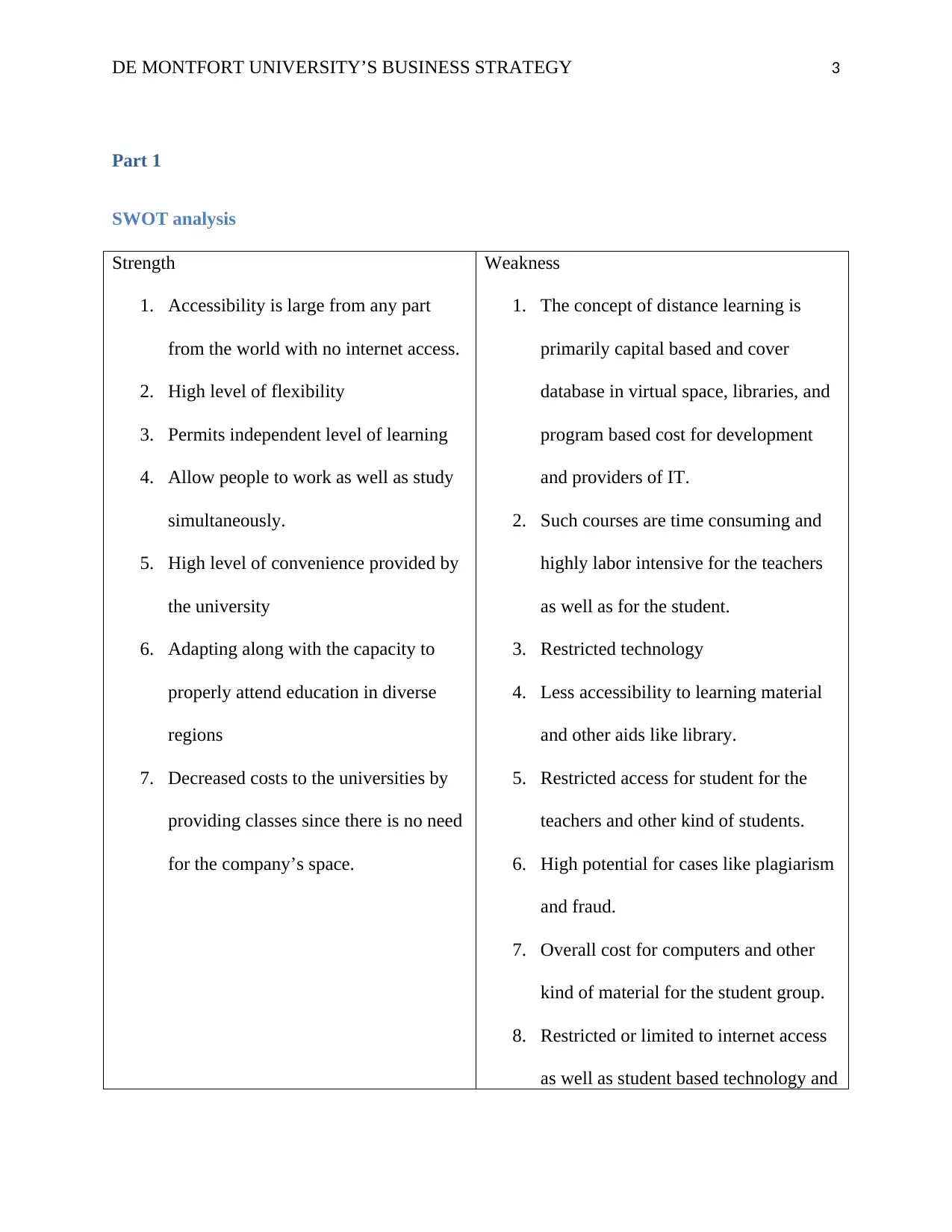
DE MONTFORT UNIVERSITY’S BUSINESS STRATEGY 3
Part 1
SWOT analysis
Strength
1. Accessibility is large from any part
from the world with no internet access.
2. High level of flexibility
3. Permits independent level of learning
4. Allow people to work as well as study
simultaneously.
5. High level of convenience provided by
the university
6. Adapting along with the capacity to
properly attend education in diverse
regions
7. Decreased costs to the universities by
providing classes since there is no need
for the company’s space.
Weakness
1. The concept of distance learning is
primarily capital based and cover
database in virtual space, libraries, and
program based cost for development
and providers of IT.
2. Such courses are time consuming and
highly labor intensive for the teachers
as well as for the student.
3. Restricted technology
4. Less accessibility to learning material
and other aids like library.
5. Restricted access for student for the
teachers and other kind of students.
6. High potential for cases like plagiarism
and fraud.
7. Overall cost for computers and other
kind of material for the student group.
8. Restricted or limited to internet access
as well as student based technology and
Part 1
SWOT analysis
Strength
1. Accessibility is large from any part
from the world with no internet access.
2. High level of flexibility
3. Permits independent level of learning
4. Allow people to work as well as study
simultaneously.
5. High level of convenience provided by
the university
6. Adapting along with the capacity to
properly attend education in diverse
regions
7. Decreased costs to the universities by
providing classes since there is no need
for the company’s space.
Weakness
1. The concept of distance learning is
primarily capital based and cover
database in virtual space, libraries, and
program based cost for development
and providers of IT.
2. Such courses are time consuming and
highly labor intensive for the teachers
as well as for the student.
3. Restricted technology
4. Less accessibility to learning material
and other aids like library.
5. Restricted access for student for the
teachers and other kind of students.
6. High potential for cases like plagiarism
and fraud.
7. Overall cost for computers and other
kind of material for the student group.
8. Restricted or limited to internet access
as well as student based technology and
⊘ This is a preview!⊘
Do you want full access?
Subscribe today to unlock all pages.

Trusted by 1+ million students worldwide
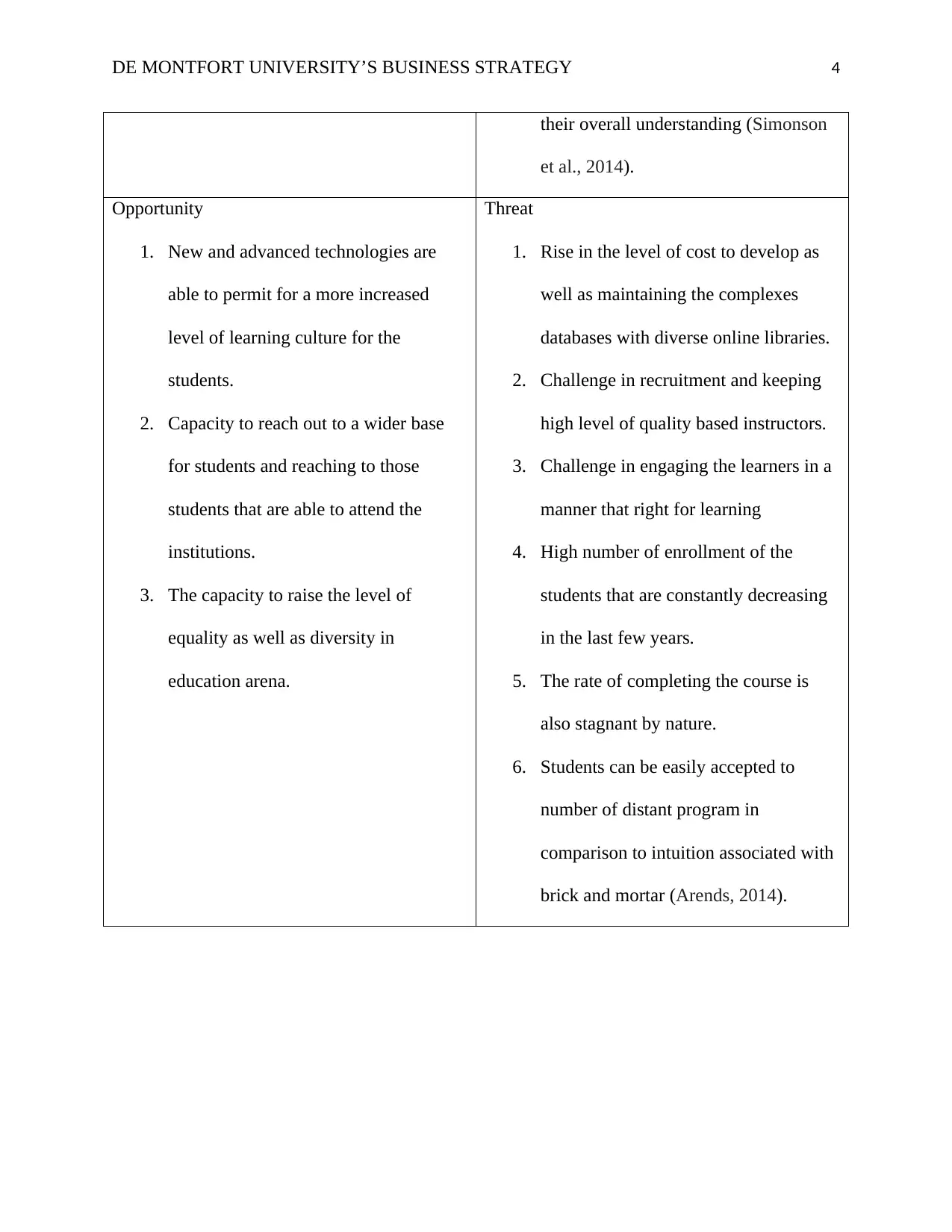
DE MONTFORT UNIVERSITY’S BUSINESS STRATEGY 4
their overall understanding (Simonson
et al., 2014).
Opportunity
1. New and advanced technologies are
able to permit for a more increased
level of learning culture for the
students.
2. Capacity to reach out to a wider base
for students and reaching to those
students that are able to attend the
institutions.
3. The capacity to raise the level of
equality as well as diversity in
education arena.
Threat
1. Rise in the level of cost to develop as
well as maintaining the complexes
databases with diverse online libraries.
2. Challenge in recruitment and keeping
high level of quality based instructors.
3. Challenge in engaging the learners in a
manner that right for learning
4. High number of enrollment of the
students that are constantly decreasing
in the last few years.
5. The rate of completing the course is
also stagnant by nature.
6. Students can be easily accepted to
number of distant program in
comparison to intuition associated with
brick and mortar (Arends, 2014).
their overall understanding (Simonson
et al., 2014).
Opportunity
1. New and advanced technologies are
able to permit for a more increased
level of learning culture for the
students.
2. Capacity to reach out to a wider base
for students and reaching to those
students that are able to attend the
institutions.
3. The capacity to raise the level of
equality as well as diversity in
education arena.
Threat
1. Rise in the level of cost to develop as
well as maintaining the complexes
databases with diverse online libraries.
2. Challenge in recruitment and keeping
high level of quality based instructors.
3. Challenge in engaging the learners in a
manner that right for learning
4. High number of enrollment of the
students that are constantly decreasing
in the last few years.
5. The rate of completing the course is
also stagnant by nature.
6. Students can be easily accepted to
number of distant program in
comparison to intuition associated with
brick and mortar (Arends, 2014).
Paraphrase This Document
Need a fresh take? Get an instant paraphrase of this document with our AI Paraphraser

DE MONTFORT UNIVERSITY’S BUSINESS STRATEGY 5
Part 2
Porter’s competitive forces model
Competencies and resources required
The competencies and the resources needed for the course is more of process based rather
subject focused. But it is also important to understand that it can be an error to look at the
competencies as being an independent identity of the topic or the domain in which it is required
to be used. For example, the solving the problem in a course like engineering need knowledge of
the physics and other similar subject areas related to materials where it is important to have
necessary knowledge of diverse fields (Wild et al., 2014). The research done here is substantial
and it also shows that competencies cannot easily be transferred from one domain to another.
The main challenge here is that skills required for the subject must be properly embedded.
Part 2
Porter’s competitive forces model
Competencies and resources required
The competencies and the resources needed for the course is more of process based rather
subject focused. But it is also important to understand that it can be an error to look at the
competencies as being an independent identity of the topic or the domain in which it is required
to be used. For example, the solving the problem in a course like engineering need knowledge of
the physics and other similar subject areas related to materials where it is important to have
necessary knowledge of diverse fields (Wild et al., 2014). The research done here is substantial
and it also shows that competencies cannot easily be transferred from one domain to another.
The main challenge here is that skills required for the subject must be properly embedded.

DE MONTFORT UNIVERSITY’S BUSINESS STRATEGY 6
Competition existence
De Montfort University is situation in UK and this is why, the university is facing a lot of
competition from European competitors which are constantly investing in strengthening their
foundation for higher education and also offers courses in subjects like English and other
specialized courses to attract global students. The universities in different parts of Europe like
Zurich are becoming top universities and even excelling in rank chart as well. Then there are
universities in US as well which are quite popular in the world like Stanford, California Institute
and many more (Liebowitz and Frank, 2016). However, universities across Europe are slowly
climbing up the chart and the becoming the threat for the De Montfort University.
What organization changes are required for distance learning courses?
The changes required must be based on some contemporary kind of change management
principles and diverse strategies which focus on assisting the students to gain more clarity on the
overall nature of changes and how it must be managed (Simpson, 2013).
Part 3
Recommendation
Following are the recommendations suggesting the actions DMU can take on website to attract
more target audience: -
1. It is very important to consider the final product and elements like teaching, process of
teaching, traditional methods along electronic aids must be integrated. Teaching must use
real or electronic medium along with physical aspects to inculcate a space which three
dimensional. It is important to understand here that the concept of virtual teaching,
despite its online location must come up with physical kind of space (Jordan, 2014.).
Competition existence
De Montfort University is situation in UK and this is why, the university is facing a lot of
competition from European competitors which are constantly investing in strengthening their
foundation for higher education and also offers courses in subjects like English and other
specialized courses to attract global students. The universities in different parts of Europe like
Zurich are becoming top universities and even excelling in rank chart as well. Then there are
universities in US as well which are quite popular in the world like Stanford, California Institute
and many more (Liebowitz and Frank, 2016). However, universities across Europe are slowly
climbing up the chart and the becoming the threat for the De Montfort University.
What organization changes are required for distance learning courses?
The changes required must be based on some contemporary kind of change management
principles and diverse strategies which focus on assisting the students to gain more clarity on the
overall nature of changes and how it must be managed (Simpson, 2013).
Part 3
Recommendation
Following are the recommendations suggesting the actions DMU can take on website to attract
more target audience: -
1. It is very important to consider the final product and elements like teaching, process of
teaching, traditional methods along electronic aids must be integrated. Teaching must use
real or electronic medium along with physical aspects to inculcate a space which three
dimensional. It is important to understand here that the concept of virtual teaching,
despite its online location must come up with physical kind of space (Jordan, 2014.).
⊘ This is a preview!⊘
Do you want full access?
Subscribe today to unlock all pages.

Trusted by 1+ million students worldwide
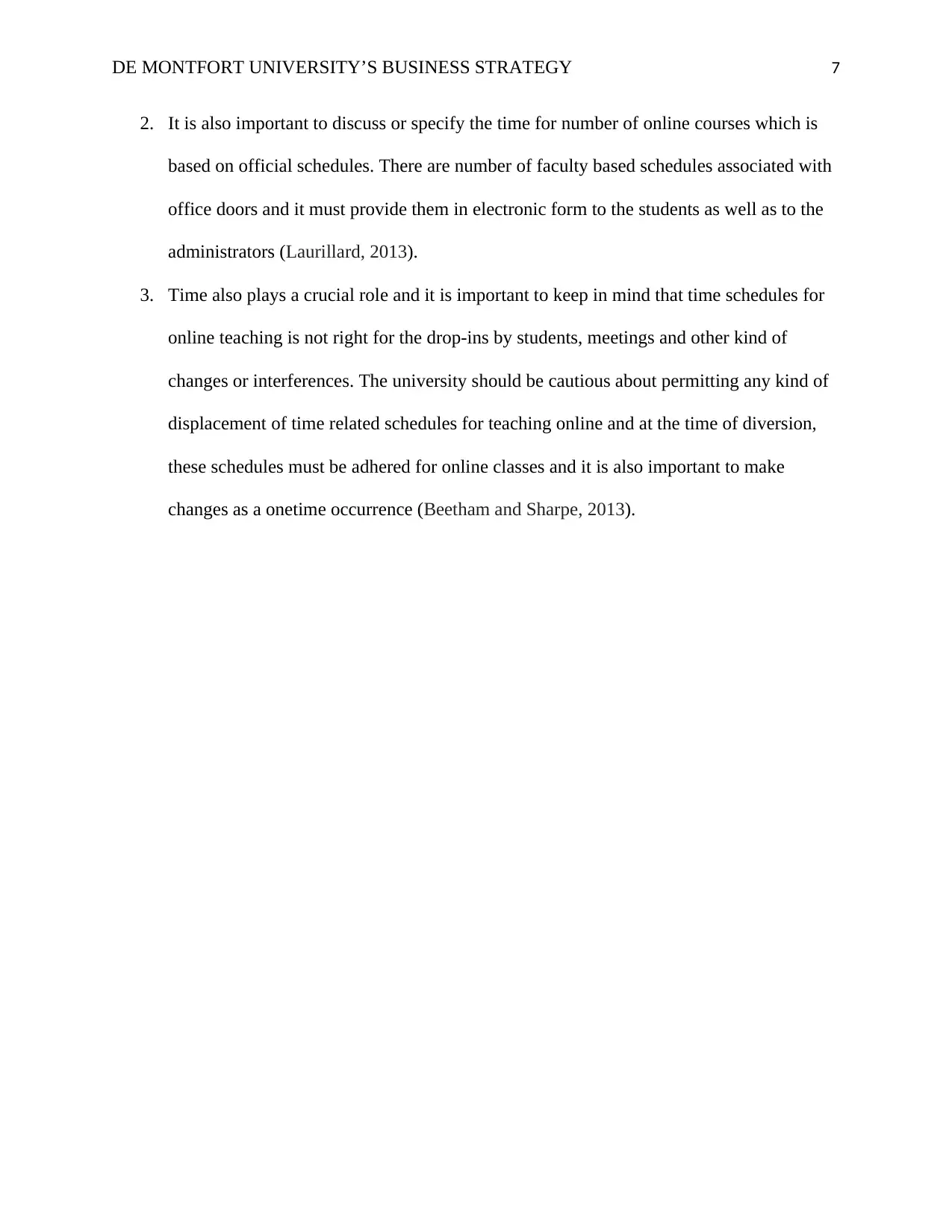
DE MONTFORT UNIVERSITY’S BUSINESS STRATEGY 7
2. It is also important to discuss or specify the time for number of online courses which is
based on official schedules. There are number of faculty based schedules associated with
office doors and it must provide them in electronic form to the students as well as to the
administrators (Laurillard, 2013).
3. Time also plays a crucial role and it is important to keep in mind that time schedules for
online teaching is not right for the drop-ins by students, meetings and other kind of
changes or interferences. The university should be cautious about permitting any kind of
displacement of time related schedules for teaching online and at the time of diversion,
these schedules must be adhered for online classes and it is also important to make
changes as a onetime occurrence (Beetham and Sharpe, 2013).
2. It is also important to discuss or specify the time for number of online courses which is
based on official schedules. There are number of faculty based schedules associated with
office doors and it must provide them in electronic form to the students as well as to the
administrators (Laurillard, 2013).
3. Time also plays a crucial role and it is important to keep in mind that time schedules for
online teaching is not right for the drop-ins by students, meetings and other kind of
changes or interferences. The university should be cautious about permitting any kind of
displacement of time related schedules for teaching online and at the time of diversion,
these schedules must be adhered for online classes and it is also important to make
changes as a onetime occurrence (Beetham and Sharpe, 2013).
Paraphrase This Document
Need a fresh take? Get an instant paraphrase of this document with our AI Paraphraser
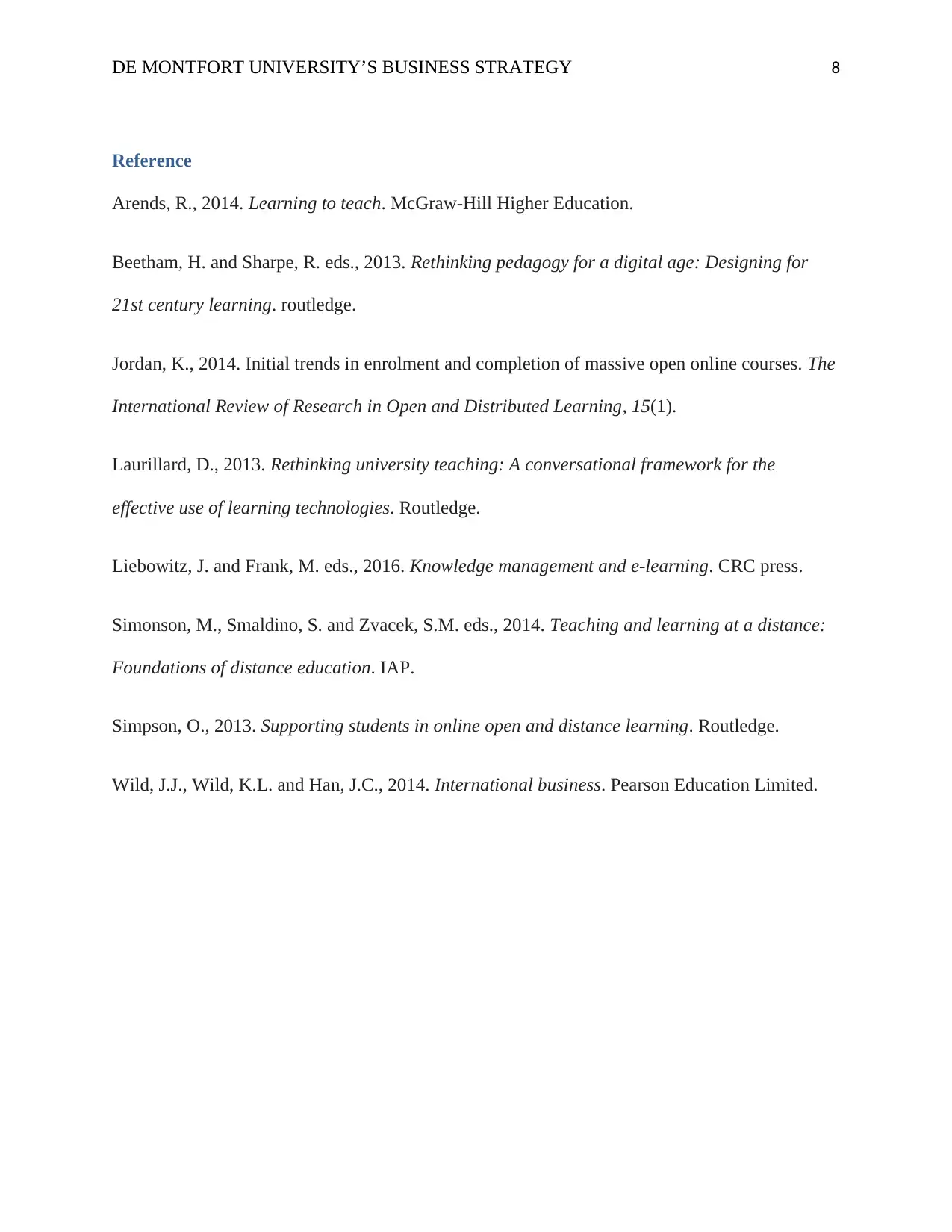
DE MONTFORT UNIVERSITY’S BUSINESS STRATEGY 8
Reference
Arends, R., 2014. Learning to teach. McGraw-Hill Higher Education.
Beetham, H. and Sharpe, R. eds., 2013. Rethinking pedagogy for a digital age: Designing for
21st century learning. routledge.
Jordan, K., 2014. Initial trends in enrolment and completion of massive open online courses. The
International Review of Research in Open and Distributed Learning, 15(1).
Laurillard, D., 2013. Rethinking university teaching: A conversational framework for the
effective use of learning technologies. Routledge.
Liebowitz, J. and Frank, M. eds., 2016. Knowledge management and e-learning. CRC press.
Simonson, M., Smaldino, S. and Zvacek, S.M. eds., 2014. Teaching and learning at a distance:
Foundations of distance education. IAP.
Simpson, O., 2013. Supporting students in online open and distance learning. Routledge.
Wild, J.J., Wild, K.L. and Han, J.C., 2014. International business. Pearson Education Limited.
Reference
Arends, R., 2014. Learning to teach. McGraw-Hill Higher Education.
Beetham, H. and Sharpe, R. eds., 2013. Rethinking pedagogy for a digital age: Designing for
21st century learning. routledge.
Jordan, K., 2014. Initial trends in enrolment and completion of massive open online courses. The
International Review of Research in Open and Distributed Learning, 15(1).
Laurillard, D., 2013. Rethinking university teaching: A conversational framework for the
effective use of learning technologies. Routledge.
Liebowitz, J. and Frank, M. eds., 2016. Knowledge management and e-learning. CRC press.
Simonson, M., Smaldino, S. and Zvacek, S.M. eds., 2014. Teaching and learning at a distance:
Foundations of distance education. IAP.
Simpson, O., 2013. Supporting students in online open and distance learning. Routledge.
Wild, J.J., Wild, K.L. and Han, J.C., 2014. International business. Pearson Education Limited.
1 out of 8
Related Documents
Your All-in-One AI-Powered Toolkit for Academic Success.
+13062052269
info@desklib.com
Available 24*7 on WhatsApp / Email
![[object Object]](/_next/static/media/star-bottom.7253800d.svg)
Unlock your academic potential
Copyright © 2020–2025 A2Z Services. All Rights Reserved. Developed and managed by ZUCOL.




